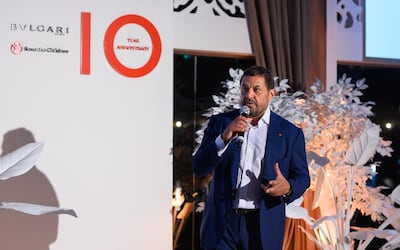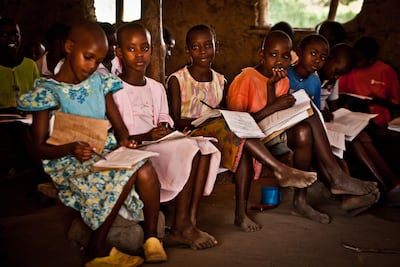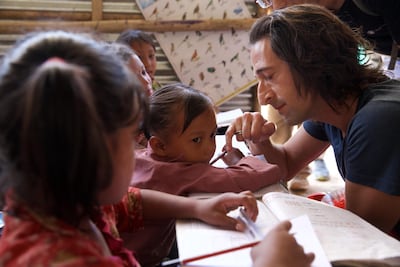One hundred years ago, as Europe emerged from the horrors of the First World War, a British social reformer, Eglantyne Jebb, came up with a radical proposition. As a result of Allied blockades, millions of children in enemy territories such as Austria and Germany were starving to death. Jebb set up Save the Children to try to alleviate some of their suffering.
“The cause she was fighting for was extremely unpopular,” reflects Claudio Tesauro, a member of the board of Save the Children International, when we meet in Dubai. “She was asking British people who had lost lots of young men in the conflict to assist the sons of their enemies, who were dying.
“The idea of assisting the son of your enemy is certainly visionary. But she always argued that there is nothing more international, in terms of language, than the cry of a baby.”

This year, Save the Children is celebrating its centenary – an occasion that is, in many ways, bittersweet. “My wish for Save the Children is that we only celebrate one centenary; that in 100 years, we will no longer exist, that the world won’t need us [anymore],” says Tesauro.
At present, the need for the organisation is as great as it was in Jebb’s lifetime. As Tesauro points out: “The challenges that children face today are unfortunately very similar to those that they faced 100 years ago. Maybe from a geographical point of view, a few things have changed but, still, an incredible number of children under the age of five die for reasons that are unacceptable.”
According to Save the Children’s 2018 annual report, an estimated 5.4 million children under the age of five still die each year from preventable causes – that’s about 15,000 everyday. Ill health, malnutrition, exclusion from education, child labour, child marriage, early pregnancy and violent death are just some of the many issues that Save the Children is trying to combat.
Immigration patterns are bringing many of these issues back to Europe – and creating a series of other complex challenges, Tesauro highlights. “How to help people at home? How to distinguish between immigration and human trafficking? How to make sure that those immigrants, once they reach a country, become a resource for that country, and not a problem to be dealt with?
“The argument has become very political. Politicians all over the world have leveraged people’s fear of immigrants to support their political manifesto and propaganda. Certainly it is a very complex argument and needs great attention, but I don’t think the answer of any civilised country can be to just close the door to people who have risked their lives to reach a better future,” he says.
In 2018, the charity helped 134 million children in 120 countries. Its campaign promise is "every last child" and its aim is for all children "to learn, survive and be protected" by 2030. Is this feasible? "Yes," Tesauro responds, without hesitation. "We have to."
In the meantime, Save the Children will also have to help rebuild trust in the NGO sector, which has been tarnished in recent years by reports of inappropriate, unethical and even illegal activities. NGOs have come under increasing scrutiny, with calls for greater transparency and accountability.
“Our founder was the first to say that an NGO has to be run like a company,” says Tesauro. “It has to have a transparent and clear balance sheet; you have to prove the origin of the money you receive and how you spend it. The success of the organisation is not actually the success of the organisation itself – it is the success of the action and scope you are trying to achieve.”
And this cannot be achieved in isolation, Tesauro maintains. "We know we cannot do it alone. We need to work with institutions; we will never be able to replace government action; and we need private stakeholders to support what we do."
One private stakeholder that has supported the organisation's efforts over the past decade is Roman jewellery brand Bulgari, which, through sales of its dedicated Save the Children jewellery collection, has raised almost $90 million (Dh330.5m) globally since 2009. This has been invested in 114 projects in 34 countries, primarily in the field of education.
Last month, Bulgari added a new piece to the collection – a disc-like pendant in sterling silver and onyx, topped with a red ruby from Mozambique. This fourth addition to the line retails at $770, with $100 from each sale going directly to Save the Children.

With the aim of boosting its overall donations to the charity to $100m within a year, Bulgari also unveiled a local campaign called Give Hope, featuring celebrities, influencers and community figures such as Lebanese actress Nadine Nassib Njeim, Saudi singer Aseel Omran, Tunisian model Rym Saidi and TV personality Diala Makki, shot by British photographer Rankin. It was also announced that, starting in Dubai this year, Bulgari Hotels and Resorts will be introducing a fundraising programme, encouraging hotel guests to make a donation upon checking out. "The relationship with Bulgari is historical," Tesauro explains. "In 10 years, we have done an incredible number of things."

He acknowledges that the partnership had to be handled delicately in the beginning – that an NGO and luxury brand do not immediately appear to be obvious bedfellows. “I mean, combining a fashion brand with a non-profit organisation was not an easy issue. It could have opened us up to the criticism that this large luxury brand just wanted to do something to make its image more acceptable. The true story is that the commitment of Bulgari has been unique since the very beginning – in terms of support, money, activities, flexibility and the people in charge.”
Importantly, Bulgari offered the NGO an immediate minimum guarantee – if sales of its Save the Children jewellery collection did not reach the pledged amount, it would cover the shortfall. It was also able to leverage its relationships with celebrities and influencers, to help spread the word about Save the Children's initiatives worldwide – enlisting about 300 high-profile individuals to become involved on a pro-bono basis.
“Those people can make the world aware of what we are doing,” says Tesauro. “They have a capacity that is unique, to speak to a vast number of people around the world. That is very strong.”




